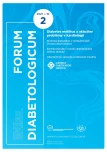Catheter ablation of atrial fibrillation in patients with diabetes mellitus
Authors:
Martin Škamla; Ubica Horváthová
Authors‘ workplace:
Oddelenie arytmií SÚSCCH, a. s., Banská Bystrica
Published in:
Forum Diab 2021; 10(2): 87-92
Category:
Overview
Atrial fibrillation is the most common arrhythmia in clinical practice. Diabetes mellitus is an independent risk factor for atrial fibrillation and increases the risk of atrial fibrillation by 40 %. Catheter ablation of atrial fibrillation is one of the established therapeutic procedures with proven higher effectiveness compared to drug treatment. It has a firm place in the treatment strategy of rhythm control in diabetics with several specifics that must be taken into account when selecting suitable patients. Patients with diabetes are characterized by an accumulation of risk factors for the onset and progression of atrial fibrillation. To ensure sufficient effectiveness of catheter ablation and the whole rhythm control strategy, a radical and comprehensive modification of all risk factors and comorbidities is necessary.
Keywords:
atrial fibrillation – catheter ablation – diabetes mellitus – risk factors for atrial fibrillation
Sources
1. Ball J, Carrington MJ, McMurray JJ et al. Atrial fibrillation: Profile and burden of an evolving epidemic in the 21st century. Int J Cardiol 2013; 167(5): 1807–1824. Dostupné z DOI: <http://dx.doi.org/10.1016/j.ijcard.2012.12.093>.
2. Hindricks G, Potpara T, Dagres N et al. 2020 ESC Guidelines for the diagnosis and management of atrial fibrillation developed in collaboration with the European Association for Cardio-Thoracic Surgery (EACTS): The Task Force for the diagnosis and management of atrial fibrillation of the European Society of Cardiology (ESC) Developed with the special contribution of the European Heart Rhythm Association (EHRA) of the ESC. Eur Heart J 2021; 42(5): 373–498. Dostupné z DOI: <http://dx.doi.org/10.1093/eurheartj/ehaa612>.
3. Dobbin S, Fisher M, McKay G. Management of atrial fibrillation in diabetes. Pract Diabetes 2018; 35(1): 27–31. Dostupné z DOI: <https://doi.org/10.1002/pdi.2155>.
4. Wang A, Green JB, Halperin JL et al. Atrial Fibrillation and Diabetes Mellitus: JACC Review Topic of the Week. J Am Coll Cardiol 2019; 74(8): 1107–1115. Dostupné z DOI: <http://dx.doi.org/10.1016/j.jacc.2019.07.020>.
5. Goudis CA, Korantzopoulos P, Ntalas IV et al. Diabetes mellitus and atrial fibrillation: Pathophysiological mechanisms and potential upstream therapies. Int J Cardiol 2015; 184: 617–622. Dostupné z DOI: <http://dx.doi.org/10.1016/j.ijcard.2015.03.052>.
6. Russo I, Frangogiannis NG. Diabetes-associated cardiac fibrosis: Cellular effectors, molecular mechanisms and therapeutic opportunities. J Mol Cell Cardiol 2016; 90: 84–93. Dostupné z DOI: <http://dx.doi.org/10.1016/j.yjmcc.2015.12.011>.
7. Kadappu KK, Boyd A, Eshoo S et al. Changes in left atrial volume in diabetes mellitus: more than diastolic dysfunction? Eur Heart J Cardiovasc Imaging 2012; 13(12): 1016–1023. Dostupné z DOI: <http://dx.doi.org/10.1093/ehjci/jes084>.
8. Echouffo-Tcheugui JB, Shrader P, Thomas L et al. Care Patterns and Outcomes in Atrial Fibrillation Patients with and without Diabetes: ORBIT- AF Registry. J Am Coll Cardiol. 2017; 70(11): 1325–1335. Dostupné z DOI: <http://dx.doi.org/10.1016/j.jacc.2017.07.755>.
9. Sandhu RK, Conen D, Tedrow UB et al. Predisposing Factors Associated With Development of Persistent Compared With Paroxysmal Atrial Fibrillation. J Am Heart Assoc 2014; 3(3): e000916. Dostupné z DOI: <http://dx.doi.org/10.1161/JAHA.114.000916>.
10. Ebert M, Stegmann C, Kosiuk J et al. Predictors, management, and outcome of cardioversion failure early after atrial fibrillation ablation. Europace 2018; 20(9): 1428–1434. Dostupné z DOI: <http://dx.doi.org/10.1093/europace/eux327>.
11. Anselmino M, Matta M, D’Ascenzo F et al. Catheter ablation of atrial fibrillation in patients with diabetes mellitus: a systematic review and meta-analysis. Europace 2015; 17(10): 1518–25. Dostupné z DOI: <http://dx.doi.org/10.1093/europace/euv214>.
12. Calkins H, Hindricks G, Cappato R et al. 2017 HRS/EHRA/ECAS/ APHRS/SOLAECE expert consensus statement on catheter and surgical ablation of atrial fibrillation: Executive summary. Europace 2018; 20(1): 157–208. Dostupné z DOI: <http://dx.doi.org/10.1093/europace/eux275>.
13. Škamla M, Bystriansky A. Ideálny kandidát na katétrovú liečbu fibrilácie predsiení. Kardiol Prax 2017; 15(1): 26–29.
14. Pathak RK, Middeldorp ME, Lau DH et al. Aggressive Risk Factor Reduction Study for Atrial Fibrillation and Implications for the Outcome of Ablation: The ARREST-AF Cohort Study. J Am Coll Cardiol 2014; 64(21): 2222–2231. Dostupné z DOI: <http://dx.doi.org/10.1016/j.jacc.2014.09.028>.
15. Donnellan E, Aagaard P, Kanj M et al. Association Between Pre-Ablation Glycemic Control and Outcomes Among Patients With Diabetes Undergoing Atrial Fibrillation Ablation. JACC Clin Electrophysiol 2019; 5(8): 897–903. Dostupné z DOI: <http://dx.doi.org/10.1016/j.jacep.2019.05.018>.
16. Pathak Rajeev K, Middeldorp ME, Meredith M et al. Long-Term Effect of Goal-Directed Weight Management in an Atrial Fibrillation Cohort. J Am Coll Cardiol 2015; 65(20): 2159–2169. Dostupné z DOI: <http://dx.doi.org/10.1016/j.jacc.2015.03.002>.
Labels
Diabetology Endocrinology Internal medicineArticle was published in
Forum Diabetologicum

Most read in this issue
- Left ventricular hypertrophy in patients with diabetes mellitus: what we don‘t think about?
- Catheter ablation of atrial fibrillation in patients with diabetes mellitus
- Alternative ways of insulin application
- Cardioprotective effect of treatment by GLP-1 analogues in the view of results of newest clinical studies
